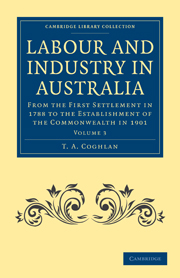 Labour and Industry in Australia
Labour and Industry in Australia Book contents
IV - LAND AND SETTLEMENT
Published online by Cambridge University Press: 07 October 2011
Summary
NEW SOUTH WALES
The year 1872, though it was marked by no new land legislation, was the beginning of a new era in the history of the land question in New South Wales, for in that year alienation of the public estate began to take place on a vast scale.
A very few years' experience of the working of free selection before survey was sufficient to convince the squatters that it would be necessary for them to purchase a large portion of their runs, if they wished to hold their leases with safety, as almost from the passing of the Robertson Land Act in 1861 there had been a class, whose numbers rapidly increased, which saw in free selection a powerful means of victimizing the leaseholders. It was not until 1872 that the squatters were able to defend their interests in the way they desired. In that year the commercial depression, following the crisis of 1866, completely passed away; money, which had previously been lacking, became plentifully available for investment in land and the banks willingly lent themselves to strengthening the squatters' position against the predatory selector. A change in the policy of the Government in regard to auction sales also gave the squatters facilities for acquiring land that they had not previously enjoyed.
The selection of land under conditions of residence was the method of purchase most favoured by the Governments that administered the Act during its early years, and sales of land by auction, although revenue was badly needed, were not therefore encouraged.
- Type
- Chapter
- Information
- Labour and Industry in AustraliaFrom the First Settlement in 1788 to the Establishment of the Commonwealth in 1901, pp. 1346 - 1404Publisher: Cambridge University PressPrint publication year: 2011First published in: 1918
